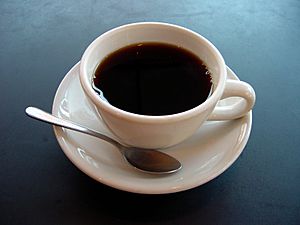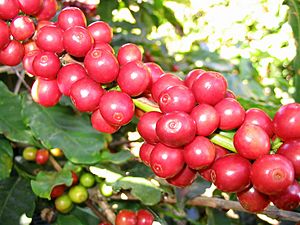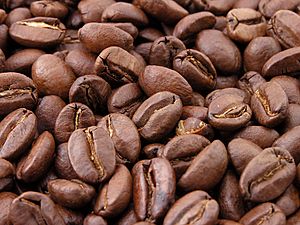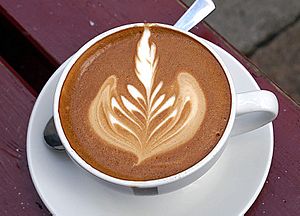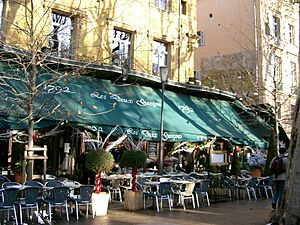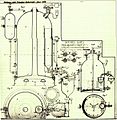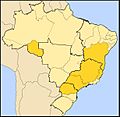Coffee facts for kids
Coffee is a popular drink made from the seeds of the coffee plant. This plant is a bush or tree that can grow quite tall, but farmers usually keep it shorter. Coffee plants first grew in Africa. Now, they also grow in places like South America, Central America, and Southeast Asia. Growing coffee is very important for the money of many countries.
The drink we call coffee comes from the plant's seeds, which are known as coffee beans. People usually drink coffee hot. It's a favorite drink in many parts of the world. Coffee has a special chemical called caffeine. Caffeine is a mild substance that helps people feel more awake and focused.
To make coffee, the beans need special steps. First, they are dried after being picked. This helps keep them fresh. Then, they are roasted. Before brewing, the roasted beans are ground into tiny pieces using a coffee mill. When these ground pieces are put into boiling water, their flavor and dark brown color mix into the water. This process is called brewing coffee. There are many different ways to brew a cup of coffee!
Contents
Types of Coffee Plants
There are two main kinds of coffee plants that give us beans:
- Arabica Coffee: This is the most common type. Most of the coffee drunk around the world comes from Arabica beans.
- Robusta Coffee: This type is easier to grow in places where Arabica plants might not do well.
Robusta coffee is usually cheaper and has more caffeine than Arabica. It's often used in many store-bought coffee products. However, Robusta can taste a bit bitter and sour on its own. So, people often mix it with other things. Some better quality Robusta beans are used in certain espresso blends.
In the past, new Arabica coffees were named after the port they were shipped from. Two very old Arabica coffees are "Mocha" and "Java." Today, coffee names are more exact. They tell you the country, region, and sometimes even the specific farm where the beans came from.
Making Coffee Beans Ready
Aging Coffee Beans
Some types of coffee taste even better if their beans are "aged." This means that after the beans are picked and dried, they are stored for three to eight years. This "aging" process makes the coffee taste less sour. Aged coffee is often mixed, or "blended," with other coffee that hasn't been aged.
Roasting Coffee Beans
"Roasting" is a very important step in turning coffee beans into the coffee we drink. When a coffee bean is roasted, it almost doubles in size. It also changes color from green to yellow, and then to brown.
How long the coffee beans are roasted changes the taste of the coffee. Some coffees, like Mocha and Java, are roasted for a shorter time. This makes it easy to taste where the coffee is from. When coffee is roasted for a long time, it's harder to tell the different types apart. You can even buy green coffee beans and roast them at home in your oven!
Grinding Coffee Beans
Before coffee is made into a drink, it is "ground" into very small pieces. This is done using a small machine called a "coffee mill."
The way coffee is ground depends on how you plan to brew it. For some methods, like "espresso," the coffee needs to be ground into a very fine powder. But for other types, like "filtered coffee," the pieces are larger so they don't go through the filter. Finely ground coffee usually makes a stronger tasting drink.
Brewing Coffee
Making coffee into a drink by putting it into boiling water is called "brewing." There are many ways to brew coffee. Here are four popular methods:
- Boiling: Coffee and water are put into a pot and slowly boiled together on the stove. This is a very old way to make coffee, used for hundreds of years. It's common in the Middle East, North Africa, Turkey, and Greece.
- Pressure: In this method, a machine forces boiling water through the ground coffee. This type of coffee is called Espresso, and the machine is an "Espresso machine." Espresso machines are often found in cafes and restaurants. Espresso is a very strong coffee that can be used to make many other coffee drinks.
- Gravity: Filtered coffee is made by gravity. Boiling water drips from a machine onto the coffee grounds. The coffee grounds are held in a paper or metal "filter." The water runs through the filter, picking up color and flavor, but the tiny coffee pieces stay behind. The flavored water then drips into a coffee pot.
- Steeping: For steeping, boiling water is poured over the coffee grounds and left to sit for a while. This lets the water soak up the color and flavor. This is often done in a cafetière. This is a tall glass pot with a special filter inside that can be pushed down when the coffee is ready. This keeps the coffee grounds at the bottom so you don't drink them. Another steeping method uses small coffee packets, just right for one cup. You place the packet in your cup, pour hot water over it, and then remove the packet.
How People Enjoy Their Coffee
People drink coffee in many different ways:
- Black coffee is coffee with no milk added.
- White coffee is coffee with milk in it.
- Café au lait is coffee made with a lot of hot milk. It is often sweet.
- Espresso is a very strong coffee.
- Cappuccino is espresso with frothy milk (milk mixed with air). A good cappuccino should be strong. When the frothy milk is poured in, it should be white on top with a darker coffee ring around the edge. Sometimes, cocoa powder is sprinkled on top.
- Latte is made like a cappuccino but has more milk and a very thin layer of foam.
- Flat white is a double espresso with milk micro-foam added to the crema (the creamy layer on top of espresso).
- Americano is espresso mixed with a lot of hot water.
- Irish coffee is coffee with whiskey and cream on top.
- Iced coffee is espresso in a tall glass with crushed ice, cold milk, and ice cream.
- Vietnamese style coffee (Cafe Sua Da) is filtered coffee poured over ice into a glass with sweet condensed milk (thick milk with water removed).
- Baby-cino is a small hot milk drink, perfect for children.
Instant Coffee
"Instant coffee" is a very fast way to make a cup of coffee. It's made in a factory and sold in jars or packets. First, a strong coffee liquid is made from ground coffee and hot water. Then, the coffee grounds are filtered out. The coffee liquid is dried until only tiny crunchy pieces (granules) or fine powder are left. These are then put into jars or packets.
When you add a spoonful of "instant coffee" to boiling water, it dissolves quickly to make a drinkable coffee. The taste can be quite different from fresh coffee. This is partly because Robusta coffee beans are usually used for instant coffee, as they cost less than Arabica beans.
When People Drink Coffee
The United States buys the most coffee, with Germany coming in second. However, people in Finland drink the most coffee per person. In Canada, the United States, and Europe, some restaurants mainly sell coffee. These are called "cafés" or "coffeehouses." Cafés often sell food, but the type of food can be different in various countries.
In some countries, like those in northern Europe, people enjoy having coffee parties. At these parties, people drink coffee and eat cake.
In many countries, people drink coffee at work. For example, in the United States and England, people often drink it in the morning. In other countries, such as Mexico, people might drink it in the evening to help them stay awake.
Coffee and Your Health
Coffee contains caffeine, which is a mild stimulant. This means it can help you feel more awake and focused. Like many substances, it's best to enjoy coffee in moderation.
Some people choose to drink coffee substitutes or decaffeinated coffee, which has most of the caffeine removed.
Images for kids
-
Over the door of a Leipzig coffeeshop is a sculptural representation of a man in Turkish dress, receiving a cup of coffee from a boy.
-
Illustration of Coffea arabica plant and seeds
-
Brazilian coffee sacks
-
A coffeehouse in Cairo, 18th century
-
Café Central in Vienna, Austria. A staple of the Viennese coffee house tradition, it has remained open since 1876.
-
Davoser Café by Ernst Ludwig Kirchner, 1928
-
The Coffee Bearer, Orientalist painting by John Frederick Lewis (1857)
See also
 In Spanish: Café para niños
In Spanish: Café para niños


